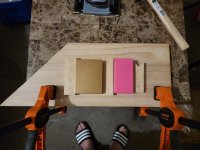Since I got my drill press drilling enclosures is easy. As I have mentioned before I use a short straight piece of timber as a fence, so the I only have one direction to get the hole wrong in.
Say you have an enclosure you want to drill for a four-knob circuit. Two at the top, two an inch lower, as is common with many PCBs. I put some masking tape on the enclosure where I want to drill the holes and mark them using a rule and a set square. I'll mark the distances with the rule and use the set square to draw a line. I use the lid of the enclosure, hold it against the side of the enclosure and press the set square against it. Across the enclosure I draw a line 15mm from the top edge and then 40.5mm. Then down the enclosure I draw lines for the horizontal alignment of the pots - often 33mm apart. So if the 1590b enclosure is 59mm wide I drawn the first line 13mm fro the left edge and 13mm from the right edge. I check that the space between them is 33mm. The holes I drill with my step bit are just a hair wider than the 6mm shaft width, so I have a little wiggle room.
Then I set up the drill press with my "fence". I set it so that the top edge of the enclosure pushes up against the fence and clamp the fence so that the drill will hit the line I drew at 40.5mm from the top. Drill the two holes where the vertical lines intersect with the horizontal lines and then your lower two pot holes are drilled. Then I have a 25.4mm wide length of timber which I hold against the fence as a spacer, use it as the fence and drill the top row of holes. I don't need to move the fence at all. It's quick and efficient and as accurate as I'll ever need. I'l flip the enclosure around to drill the hole for the stomp switch at the halfway point along a line 15mm from the bottom. The fence and spacer are already in the right place.
Then I do a similar process for the top side of the enclosure for the sockets.



